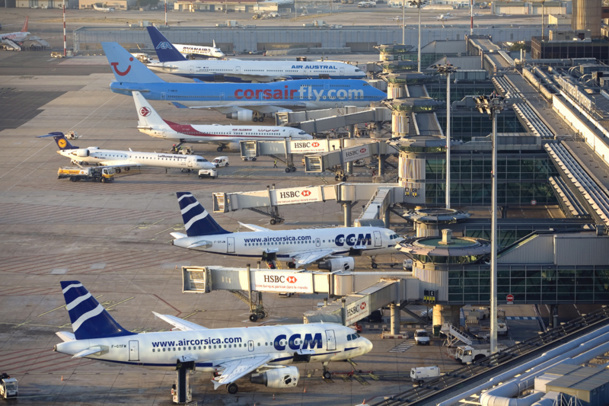
European airline companies should either keep investing or unite, following the example of American companies, to reach profitability once more DR : C.Moirenc
European airline companies are the least profitable in the world.
A situation that is well known by professionals in the sector, the consequence of a strong liberalization of the market, that took place between 1987 and 1997.
The opening of the sky gave birth to many operators and today, close to 152 companies fly on the European continent.
To attract clients, they lowered their prices, through low-costs at first, followed by traditional companies.
But with superior operational costs, these traditional companies couldn’t resist and had to sacrifice profit over promotional offers.
No need to remind once more of the financial situation of the Air France group or even Lufthansa, who are attempting to recover by launching severe savings plans.
A situation that is well known by professionals in the sector, the consequence of a strong liberalization of the market, that took place between 1987 and 1997.
The opening of the sky gave birth to many operators and today, close to 152 companies fly on the European continent.
To attract clients, they lowered their prices, through low-costs at first, followed by traditional companies.
But with superior operational costs, these traditional companies couldn’t resist and had to sacrifice profit over promotional offers.
No need to remind once more of the financial situation of the Air France group or even Lufthansa, who are attempting to recover by launching severe savings plans.
Look for investment or combine businesses?
To get out of this vicious cycle, Coface, the French insurance company of foreign exchange, published a study in which it considers two solutions.
First of all, keep looking for investments, look to grasp the growing demand from Asian countries, who will make-up for the majority of growth in the future.
Just one figure demonstrates how quickly the region is developing: the number of weekly flights in China between 1992 and 2012 went from 2,184 to 52,561.
This investment strategy was chosen by Turkish Airlines who, with 48 million passengers transported in 2013, is catching a large portion of the market between the EU and Asia.
The second option that European companies will be forced to undertake due to a lack of liquidity to invest, will be to combine businesses, following the American model.
In fact, in the United States, the effects of the liberalization of the domestic market, started in 1978 with the Airlines Deregulation Act, have first boosted demand.
First of all, keep looking for investments, look to grasp the growing demand from Asian countries, who will make-up for the majority of growth in the future.
Just one figure demonstrates how quickly the region is developing: the number of weekly flights in China between 1992 and 2012 went from 2,184 to 52,561.
This investment strategy was chosen by Turkish Airlines who, with 48 million passengers transported in 2013, is catching a large portion of the market between the EU and Asia.
The second option that European companies will be forced to undertake due to a lack of liquidity to invest, will be to combine businesses, following the American model.
In fact, in the United States, the effects of the liberalization of the domestic market, started in 1978 with the Airlines Deregulation Act, have first boosted demand.
Travelers pay more than before the crisis
The appearance of new players had multiplied the openings of lines and led to a drop in prices of approximately 40% since the beginnings of market liberalization.
While this drop in prices was at first compensated by a rise in demand by 4.1% per year, this trend brutally dropped again starting September 11, 2001, without ever recovering to the same levels as before.
The financial situation of American airline companies thus rapidly degraded. They had to register in the framework of the Chapter 11 of the Bankruptcy law.
Weakened, they had to combine to streamline their networks.
Currently, only 4 of the 11 historical players still remain in the United States. American Airlines, Delta, Southwest and United Airlines now share 69% of the domestic market.
“A situation that many fear will bring on an oligopole”, explains Guillaume Baque, Sectorial Economist at Coface.
In fact, since 2009, the real price of domestic flights has increased by 15%. Previously almost inexistant before the 2000s, onboard services weigh in for 6% of the average price of a domestic flight.
This combination has been beneficial to the account of companies, but negative for travelers, who now pay more than before the crisis.
But according to the Coface studies, this is the only option suitable for European companies in order for them to be once again profitable and to hope grasping a fraction of the Asian market, a source of growth in the upcoming years.
While this drop in prices was at first compensated by a rise in demand by 4.1% per year, this trend brutally dropped again starting September 11, 2001, without ever recovering to the same levels as before.
The financial situation of American airline companies thus rapidly degraded. They had to register in the framework of the Chapter 11 of the Bankruptcy law.
Weakened, they had to combine to streamline their networks.
Currently, only 4 of the 11 historical players still remain in the United States. American Airlines, Delta, Southwest and United Airlines now share 69% of the domestic market.
“A situation that many fear will bring on an oligopole”, explains Guillaume Baque, Sectorial Economist at Coface.
In fact, since 2009, the real price of domestic flights has increased by 15%. Previously almost inexistant before the 2000s, onboard services weigh in for 6% of the average price of a domestic flight.
This combination has been beneficial to the account of companies, but negative for travelers, who now pay more than before the crisis.
But according to the Coface studies, this is the only option suitable for European companies in order for them to be once again profitable and to hope grasping a fraction of the Asian market, a source of growth in the upcoming years.




























![Tourisme : où sont passés les Chinois ? [ABO] Tourisme : où sont passés les Chinois ? [ABO]](https://www.tourmag.com/photo/art/large_16_9/87929923-62307593.jpg?v=1744721842)















